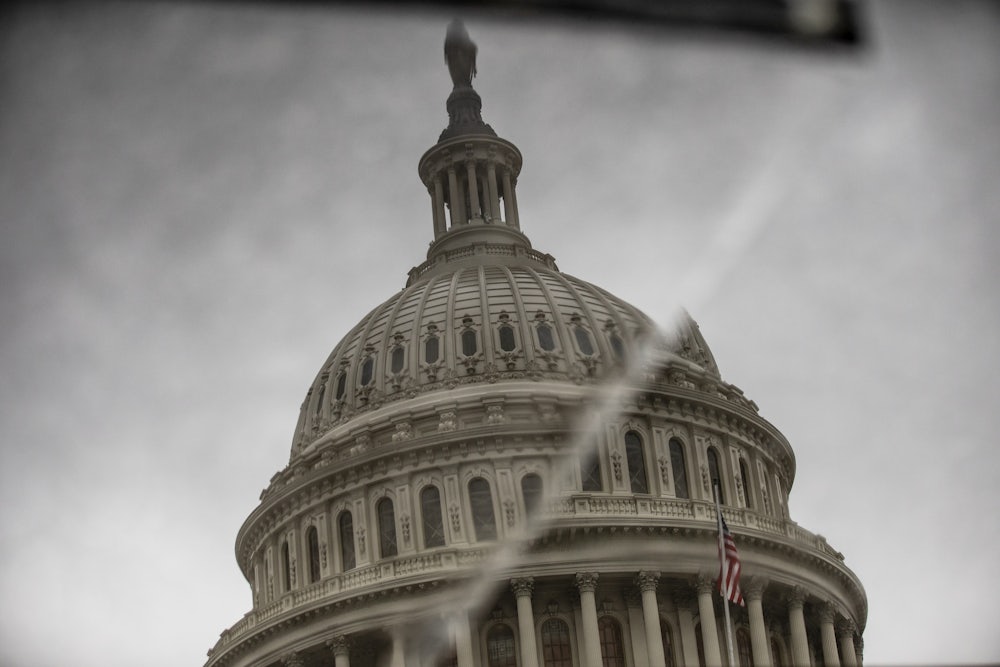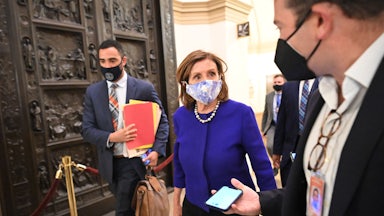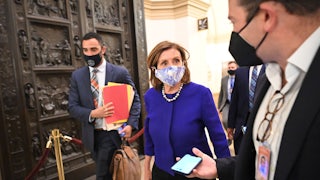Congress is careening toward a series of manufactured crises this week: a looming government shutdown that will likely be averted close to the last moment and an intraparty spat among Democrats over whether to vote on a bipartisan infrastructure bill without first approving massive legislation containing a host of President Joe Biden’s “Build Back Better” priorities.
The government will run out of funding at midnight on Thursday, which is also the arbitrary deadline agreed to by Speaker Nancy Pelosi to vote on the bipartisan bill. Dozens of House progressives have vowed to sink the infrastructure bill unless the Build Back Better Act—which is still being negotiated—is passed first. Pelosi can unilaterally push back the vote on the bipartisan bill; as she and her allies are fond of saying, the speaker does not put a bill on the floor if she does not have the votes to pass it.
This is proving to be a challenging series of complications for lawmakers to address and for reporters to cover. And one can only imagine what ordinary Americans are making of the confusion—for people who are not hyperengaged with Capitol Hill’s machinations but who have been led to believe that they are being ostensibly guided by adult professionals, the bewildering array of crises, conflicts, and coalitions can be pure, undistilled frustration. But let’s throw another emergency on the pile: Lawmakers must also vote to suspend or raise the debt limit before the country defaults. Treasury Secretary Janet Yellen has anticipated that default will occur on October 18, which could have catastrophic consequences, including the potential loss of six million jobs and wiping out $15 trillion in household wealth.
Republicans are refusing to support Democratic efforts to suspend the debt limit. On Monday, Senate Republicans blocked a continuing resolution, or C.R., funding the government through early December, because the bill also included a debt limit suspension. (Congress is expected to pass a “clean” C.R. not including a debt ceiling extension on Thursday, thus avoiding a shutdown.)
With all of these crises coming to a head, and with no clear resolution, it behooves us to ask: Is this normal? Or is Congress more dysfunctional than ever?
While flirting with a shutdown is not exactly the picture of good governance, it is not unusual. Nor is it uncommon for the majority party to use the process of reconciliation to pass policy priorities. In recent years, the fight over the debt ceiling has also become a regular display of political brinkmanship. But the current impasse over the debt limit is new because the level of intransigence among the members of the GOP—who are not just voting against suspending it but filibustering Democratic efforts to raise the ceiling—is without precedent.
“The dysfunction related to the debt limit is something a little bit different than what we’ve seen before, and then that is having cascading effects,” said Molly Reynolds, a senior fellow in governance studies at the Brookings Institute.
Republicans argue that Democrats can raise the debt ceiling by themselves, as they control the House, Senate, and White House. The minority party has occasionally opted not to support the majority’s efforts to raise or suspend the limit. In 2006, Democrats refused to join Republicans in voting to raise the ceiling. But although Democrats didn’t vote to raise the ceiling that year, they didn’t block it, either; they allowed it to pass with a simple majority without filibustering.
Senate Minority Leader Mitch McConnell on Tuesday blocked Senate Democrats from passing a debt ceiling suspension with a simple majority vote—which would not require any Republican to support it. Republicans argue that Democrats should raise the debt ceiling through reconciliation, a long and complicated process that may not be complete by October 18. The House is voting on a bill to suspend the debt ceiling on Wednesday, but there is no indication that Republicans will back down and allow this bill to pass in the Senate.
Because there is little bipartisan overlap between the two parties, reconciliation has basically become the only option for the majority party to pass any of its priorities, because the minority will filibuster most every other issue. Democrats are using the reconciliation process to try to pass the Build Back Better Act, as it allows certain legislation to be approved with only a simple majority in the Senate, instead of the 60 votes needed to overcome a filibuster.
This is why negotiations over the bipartisan bill and the reconciliation bill are so agonizing—Democrats have exceedingly narrow majorities in both houses of Congress, meaning that leadership can’t afford to lose any votes on either bill. The reconciliation bill has to be amenable to moderates, and the bipartisan bill can’t pass unless they feel their desires for the former measure have been sufficiently satisfied.
“It just puts more and more pressure on the reconciliation process, because it’s the only avenue that the majority has to do these things. It can lead to kind of kludgy policymaking in the process, because if you’re going to use reconciliation, you get the benefit of not having the filibuster. But you have to make things fit into the procedural box that reconciliation creates,” Reynolds said.
There are several strict rules for using reconciliation, which is only intended for budgetary measures, further complicating negotiations over what should be included in the bill. The Senate parliamentarian, the expert on the arcane rules of the chamber, can issue opinions on what can and can’t be included in legislation passed under reconciliation. Parliamentarian Elizabeth MacDonough has recently drawn the ire of progressives for ruling that a $15 federal minimum wage could not be included in the American Rescue Plan, the massive coronavirus relief measure that passed in March, and that immigration reform could not be included in this current bill.
Functionally, the excessive use of the filibuster, paired with the stringent requirements of reconciliation, means that several of Democrats’ priorities are destined to die in the Senate. Bills on voting rights or codifying Roe v. Wade can pass the House without any Republican votes, but unless 10 Republicans agree to advance the bill—and they won’t—it will fail in the upper chamber.
But no matter how often the filibuster stymies the Democratic agenda, it’s common knowledge that at least two senators are opposed to eliminating it: Senators Joe Manchin and Kyrsten Sinema, who are also the two biggest holdouts on the reconciliation bill. This leaves reconciliation as the last best hope for accomplishing the majority’s priorities.
Use of the filibuster has increased dramatically in recent years. Although it’s difficult to know how frequently the filibuster is used, a useful proxy measure is how often cloture motions are filed. Of the more than 2,000 filed since 1917, more than half have been filed in the past 15 years. In the modern era, there has been increased competition for control of Congress, meaning that the minority party has an incentive to block the priorities of the majority.
“You don’t want to make the current majority look good by cooperating with them and giving them legislative wins,” Reynolds said. The flip side of that coin is making the majority look bad by contributing to legislative losses. Although a default on the country’s debt would be disastrous for the economy, it may be associated with a Democratic-controlled legislature and White House rather than the Republican minority, which is already structurally advantaged to retake Congress in the midterm elections. Economic catastrophe under one party’s watch could look good for the other.
“The level of polarization in Congress is really just a result of the level of polarization and conflict in the political system as a whole,” Reynolds said, adding that members of Congress are often “responding to what they see as their electoral incentive.” “There’s also the current environment where … there is a sizable component of the Republican Party in Congress [that] is just not interested in making government work particularly well and willing to take steps that actively undermine democracy.”
Polarization is not a new phenomenon, but it appears to have sharpened in recent years, perhaps reaching its apotheosis in the January 6 insurrection, when a mob of Trump supporters overran the Capitol in an attempt to overturn the election. More than 100 Republican lawmakers voted against certifying Electoral College results just hours later, and several have since downplayed the attack or even actively questioned why rioters were being prosecuted. Those who have expressed disloyalty to Trump, or refused to whitewash the events of January 6, have been ostracized within the party.
Democratic Representative Sean Casten told The New Republic that any dysfunction in Congress was concentrated in the Republican Party, which he called “completely nihilistic and willing to blow up everything.” But he argued that the current negotiations within the Democratic Party about how best to address issues such as climate change and health care show that “complicated conversations are happening in the robust way the Founders intended—they’re just only happening in one caucus.”
“Congress is very functional, but a large bloc of members of Congress have decided not to come to the table,” Casten said.
There are concerns about the functionality of Congress among Republicans, as well. On the other side of the aisle—and the Capitol—Republican Senator John Kennedy expressed frustration with how both parties are swamped in bureaucracy, saying, “There’s virtually no discussion, none, about how we can deliver your services more efficiently.”
“Congress is about as popular with the American people as a fever blister, and a lot of that is justified,” Kennedy told The New Republic. (Kennedy, along with every other Republican senator, voted against the C.R. suspending the debt ceiling and has argued that Democrats should raise it through reconciliation.)
But others in the Senate remain optimistic that, despite [*waves hand vaguely*] all this, Congress is doing better than the American people think. Democratic Senator Mark Kelly, who was elected to Congress last year, told The New Republic that “relationships across the aisle with other senators are much more positive than I would have expected.” He noted that the Senate regularly passes bills via unanimous consent, although much of that legislation is uncontroversial.
Democratic Senator Chris Murphy argued that the Senate had passed “probably more significant bipartisan legislation in the last year and a half than at any comparable time in my lifetime.” He pointed to several bipartisan coronavirus relief bills, as well as the bipartisan infrastructure bill now hitting up against a wall in the House.
“It’s true we have these perennial fights over immigration and health care, but there’s a lot of evidence in the last year and a half that Congress can tackle the big issues in a bipartisan way,” Murphy said.










